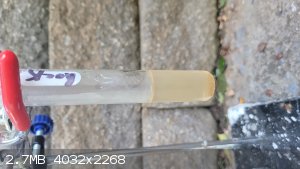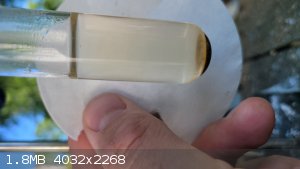Rainwater
National Hazard
   
Posts: 799
Registered: 22-12-2021
Member Is Offline
Mood: indisposition to activity
|
|
Testing for CaF2 minerals
https://www.sciencemadness.org/whisper/viewthread.php?tid=26...
Testing purple rock, so I grabbed a copy of the epa geological survey for my state and found one entry that matched this cool looking deposit I found.
Currently working out how to test if the sample contains CaF2
Im thinking
$$ H_2SO_4(l) + CaF_2(s) \rightarrow CaSO_4(s) + 2HF(g) $$
Collecting the gas produced in di water
Add ammonia solution to the di solution,
$$ HF + NH_3 \rightarrow NH_4F $$
Drying di water and recovering solids,
then then testing the sublimation temperature of the solids
100c for NH4F
336c for NH4Cl
Any suggestions for an easier route?
[Edited on 24-4-2023 by Rainwater]
"You can't do that" - challenge accepted
|
|
|
Admagistr
Hazard to Others
  
Posts: 350
Registered: 4-11-2021
Location: Central Europe
Member Is Offline
Mood: The dreaming alchemist
|
|
Many fluorites, perhaps all of them, after strong heating to hundreds of C, then glow in the dark...They will also probably react to UV radiation, due
to the frequent content of elements from the lanthanide group.
|
|
|
Rainwater
National Hazard
   
Posts: 799
Registered: 22-12-2021
Member Is Offline
Mood: indisposition to activity
|
|
Admagistr my man. I dont care what they say about you, you good in my book
No idea what wavelength this flashlight is but it shows every spill I ever had on my workbench.
The backside of the samples have no change, but the interesting material has a deep violet glow.
This picture does not do it justice.
(Edit) picture moved to pertty pictures thread. Couldn't get it on both without uploading it twice
[Edited on 25-4-2023 by Rainwater]
"You can't do that" - challenge accepted
|
|
|
MadHatter
International Hazard
    
Posts: 1332
Registered: 9-7-2004
Location: Maine
Member Is Offline
Mood: Enjoying retirement
|
|
High School Chemistry
One way we did it in high school chemistry was to place a small quantity of the
suspected material on a glass microscope slide. Add a couple drops of
concentrated H2SO4 on top. Granted we did this overnight. The next day if there
was a fluoride we would find holes in the glass slide. Presumably the reaction
generated HF and attacked the glass. Something to consider.
From opening of NCIS New Orleans - It goes a BOOM ! BOOM ! BOOM ! MUHAHAHAHAHAHAHA !
|
|
|
Admagistr
Hazard to Others
  
Posts: 350
Registered: 4-11-2021
Location: Central Europe
Member Is Offline
Mood: The dreaming alchemist
|
|
Hi Rainwater and thanks ,glad I could help you... ,glad I could help you...
|
|
|
Osmiridium
Harmless

Posts: 26
Registered: 13-3-2023
Member Is Offline
Mood: excited
|
|
Hydrofluoric acid is extremely dangerous and toxic.
Also it reacts with SiO2 to SiF4 so you can't use any glassware. This can be used as a test though..
Actually what MadHatter proposed is a good way to check for fluorides. It's safe and easy too.
|
|
|
chornedsnorkack
National Hazard
   
Posts: 521
Registered: 16-2-2012
Member Is Offline
Mood: No Mood
|
|
Testing for HF fumes tests only for F, not specifically for CaF2.
Wikipedia knows a lot of different fluoride minerals:
Acuminite SrAlF4(OH)·(H2O)
Apophyllite (K,Na)Ca4Si8O20(F,OH)·8H2O
Arsenuranospathite Al(UO2)2(AsO4)2F·20H2O
Artroeite PbAlF3(OH)2
Bararite (NH4)2SiF6
Bastnäsite (La, Ce, Y)CO3F
Bultfonteinite Ca2SiO2(OH,F)4
Carobbiite KF
Creedite Ca3Al2SO4(F,OH)10·2(H2O)
Cryolite Na3AlF6
Faizievite K2Na(Ca6Na)Ti4Li6Si24O66F2
Fluocerite (Ce,La)F3
Fluorapatite Ca5(PO4)3F
Fluorcaphite (Ca,Sr,Ce,Na)5(PO4)3F
Fluorcarmoite-(BaNa) Ba[]Na2Na2[]CaMg13Al(PO4)11(PO3OH)F2
Fluorite CaF2
Fluororichterite Na(NaCa)Mg5Si8O22F2
Fluorwavellite Al3(PO4)2(OH)2F•5H2O
Frankdicksonite BaF2
Gagarinite-(Ce) Na(REExCa1−x)(REEyCa1−y)F6
Gananite BiF3
Håleniusite-(La) (La,Ce)OF
Herderite CaBe(PO4)(F,OH)
Kogarkoite Na3(SO4)F
Kukharenkoite-(Ce) Ba2CeF(CO3)3
Leucophanite (Na,Ca)2BeSi2(O.OH.F)7
Neighborite NaMgF3
Rosenbergite AlF3·3H2O
Sellaite MgF2
Sonolite Mn9(SiO4)4(OH,F)2.
Strontiofluorite SrF2
Svabite Ca5(AsO4)3(F,OH)
Thomsenolite NaCaAlF6·H2O
Tilasite CaMg(AsO4)F
Villiaumite NaF
Wagnerite (Mg,Fe2+)2PO4F
Yttrocerite CaF2 + (Y,Ce)F3
Zavaritskite (BiO)F
Zharchikhite AlF(OH)2
|
|
|
j_sum1
Administrator
       
Posts: 6220
Registered: 4-10-2014
Location: Unmoved
Member Is Online
Mood: Organised
|
|
Fair point, chornedsnorkack.
But, realitically, once you have established the presence of fluoride, it it pretty straightforward to test for Ca.
|
|
|
chornedsnorkack
National Hazard
   
Posts: 521
Registered: 16-2-2012
Member Is Offline
Mood: No Mood
|
|
Quote: Originally posted by j_sum1  | Fair point, chornedsnorkack.
But, realitically, once you have established the presence of fluoride, it it pretty straightforward to test for Ca. |
2; 7; 9; 11; 13; 14; 15; 16; 17; 20; 23; 26; 32; 33; 34; 37. I get 16 distinct minerals that contain Ca and F. (Plus some possibility that the sample
contains Ca and F but in different minerals/grains).
Mind you, most of these minerals are rare. A common alternative to fluorite would be fluorapatite... which can be written as Ca5(PO4)3F or as
3Ca3(PO4)2*CaF2. Would fluorapatite count as "containing CaF2"?
[Edited on 2-5-2023 by chornedsnorkack]
|
|
|
j_sum1
Administrator
       
Posts: 6220
Registered: 4-10-2014
Location: Unmoved
Member Is Online
Mood: Organised
|
|
Right again.
I guess that brings up to minerology tests like measuring refractive index and analysing crystal structures. After that comes EDAX and xray
crystallography.
Given that CaF2 is the most common fluorude mineral (and is usually called fluorite), my guess is that the OP would be satisfied with a low-tech,
accessible and reliable test for fluorine in an insoluble material. I like the glass-etching idea best.
|
|
|
Rainwater
National Hazard
   
Posts: 799
Registered: 22-12-2021
Member Is Offline
Mood: indisposition to activity
|
|
| Quote: | | Wikipedia knows a lot of different fluoride minerals |
Correct. At the time I had no clues to follow as to the composition or the minerals.
So the next step was to search for what minerals where known to be in the area.
[rant]
The state of Georgia is little known for its old abandoned mining history.
Lots of people believe we only farmed but truth be told, mining was a large industry in the 1900s
Gold, silver, diamonds, mercury but most of all sulfer. There is not a county in the western half of the state that didnt have at least one pyrite
mine. Extraction of sulfur usually led to the discovery of gold, and in the late 50s uranium, which depending on how you look at it, you sell the
gold, and the sulfurs free, or sell the sulfur and the gold is free.
By searching the USGS website I found a list of the top minerals known to be in my state, then by searching for the word "purple" cross referenced
with the county i was in, that listed 2 possiblys.
One does not react with diluted HCl (CaF2), the other does ( Fe3(PO4)2*8H2O )
After removing the hcl solution, I added H2SO4 to the solution i removed, no percipitate was formed. My conclusion was that no lead was present in the
sample.
I posted here and got great suggestions, UV light works, sample etches glass with H2SO4 + 48 hours.
Etching sample was reactive with HCl, mostly dissolving but a raw sample was not
Tested radioactive, non existant. I got some cool color in my collection now
And it glows in the dark. Im happy
Edit: clarified what i had done.
Edit #2. I am a dumb!@@. PO and PbO are to seperate compounds with different test. Testing for lead after HCl leaching does not rule out the second
compound if that compound doesnt contain any Pb. Detail notes are a godsend. Helps me find my own mistakes
Edit#3
Im guessing, NaOH to percipitate Ca(OH)2
Can you show me the reaction?
[Edited on 2-5-2023 by Rainwater]
"You can't do that" - challenge accepted
|
|
|
j_sum1
Administrator
       
Posts: 6220
Registered: 4-10-2014
Location: Unmoved
Member Is Online
Mood: Organised
|
|
First test: sulfate precipitate.
Second test: carbonate precipitate. I would bubble CO2 through alkaline solution.
Then there is edta which is used for titrating Ca2+ ions. I forget the colours but I believe it is quite specific.
There are also indicators for Ca. I have some alizarin red which is used as a biological stain. Not sure how useful it is fo Ca in solution though.
And I would also run a flame test as a matter of course. Ca is quite different from Sr or Ba. You would need to keep Na out which probably means
redoing your etch test on high quality silica instead of a microscope slide.
|
|
|
Rainwater
National Hazard
   
Posts: 799
Registered: 22-12-2021
Member Is Offline
Mood: indisposition to activity
|
|
Let me know if I did this right
1g ore placed into borosilicate 3 test tube.
+ 5g di water
+ 5mL 98% H2SO4
Gently heated to 80c for 1 hour
Light green liquid transfered to another test tube.
Solids are gray, green
Original test tube is now frosted where the liquid level was at
Liquid turned cloudy rust red and percipitate quickly settled as KOH solution was added
Liquid was neturalized with KOH solution until ph was 8.5-9
CO2 was bubbled into collected solution, for 1 hour, no change
Perty sure I did it wrong.
I think the Ca stayed with the solids as CaSO4. That would explain why
No CaCO3 percipitates
Or it mixed in with the iron oxides percipitate as Ca(OH)2
"You can't do that" - challenge accepted
|
|
|
j_sum1
Administrator
       
Posts: 6220
Registered: 4-10-2014
Location: Unmoved
Member Is Online
Mood: Organised
|
|
Repeat using HNO3 so that you don't lose the Ca at that step.
Ca(OH)2 has slight solubility: higher than CaCO3. So you should see a fine suspension with CO2. 5 mins should be plenty.
|
|
|
chornedsnorkack
National Hazard
   
Posts: 521
Registered: 16-2-2012
Member Is Offline
Mood: No Mood
|
|
Just about any cation would precipitate out of concentrated NaOH except alkali metals, Tl and NH4 (but NH4 would give pretty specific volatilization).
So, EDTA and flame tests? In terms of a colourless metal hydroxide, how easily do they distinguish Ca from Mg (common) and Sr (rare but around)?
|
|
|
j_sum1
Administrator
       
Posts: 6220
Registered: 4-10-2014
Location: Unmoved
Member Is Online
Mood: Organised
|
|
Not sure about edta. I have not used it for this purpose (although my yt feed has recently been flooded with edta titrations for water hardness.)
Mg does not give a visible flame test.
Ca gives a brick-orange.
Sr is a brilliant deep red.
The trick is to keep Na contamination out of the mix as its colour swamps everything in a flame test.
Mg will not give a precipitate with sulfates so can be distinguished from Ca on that basis.
As with anything like this, it helps to know the history or source of your sample as this allows elimination of many possibilities.
Rightly or wrongly I interpreted the OP as being interested in fluoride ion detection with cations a secondary consideration.
|
|
|
Rainwater
National Hazard
   
Posts: 799
Registered: 22-12-2021
Member Is Offline
Mood: indisposition to activity
|
|
1.0g of ore was boiled with di water and rinsed twice.
40ml of di water and 2ml of 68% HNO3 was added.
Solution heated with a flame to gently boil for 10 minutes
Ivory cloudy solution was the result.
No glass etching is visible

After settling the solution maintained its color, much less cloudy

Half the solution was decanted and its volume more than doubled
3 dtops of solution where transfered to a vial. 1 drop of saturated AgNO3 solution was added to the solution.
White percipitate was formed
Na2CO3 solution was added to the main solution, drop wise until bubbles quit forming.
Additional Na2CO3 drops caused a change in opaqueness.
Ph~10
A white percipitate has settled to the bottom of the test tube.

Thank you all very much. No beter way to spend a vacation
"You can't do that" - challenge accepted
|
|
|